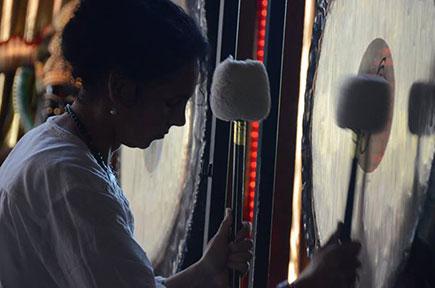How To Play A Gong
Respect Your Gongs
 There are so many ways to activate your gongs that demonstrate respect for this amazing instrument. Activate it as though you and the gong are in a mutual dance of love and attraction.
There are so many ways to activate your gongs that demonstrate respect for this amazing instrument. Activate it as though you and the gong are in a mutual dance of love and attraction.
Gongs will sound differently depending on the environment they are in, the mallets that you use, and the quality of the relationship between you and your gongs. Below are the steps for playing and maintaining your Gong correctly.
Equipment Needed
- Gong:
- Choose an appropriate gong for your intended use.
- Mallet:
- We say that mallets are everything. Paiste mallets come in many sizes designed to optimize the sound quality of each gong. There are also many specialty mallets that can be used to play the rims or to coax unique sound qualities from your gongs. Soft, padded mallets are typically used for deep, resonant sounds, while harder mallets produce sharper, brighter tones. Various special effects mallets are there for your experimentation and exploration.
- Stand or Mount:
- Ensure the gong is securely mounted or placed on a stable stand to allow it to resonate freely. There are multiple stand options available through the Acutonics store.
Playing Techniques
- Striking the Gong:
- Grip: Hold the mallet firmly but not too tightly to allow for flexibility and control.
- Position: Strike the gong slightly off-center for a fuller, more resonant sound. Hitting the center can produce a harsh, metallic sound.
- Force: Vary the force of your strikes to create different dynamics. A gentle tap produces a soft tone, while a more forceful strike can create a louder, more powerful sound.
- Angle: Strike the gong with a slight angle, not directly perpendicular to its surface, to produce a smoother sound and reduce the risk of damaging the gong.
- Creating Different Sounds:
- Rolling: Use a continuous, rolling motion with the mallet around the surface of the gong to create a sustained, swelling sound.

- Muffling: Use your hand or another mallet to muffle the gong gently after striking to control the duration and decay of the sound.
- Variety of Strikes: Experiment with striking different areas (edge, near the center) and with different parts of the mallet (head, handle) to explore a range of tones and effects.
- Rolling: Use a continuous, rolling motion with the mallet around the surface of the gong to create a sustained, swelling sound.
- Dynamics and Expression:
- Crescendo and Decrescendo: Gradually increase or decrease the intensity of your strikes to create dynamic changes in the sound.
- Rhythm and Patterns: Develop rhythmic patterns by varying the timing and intensity of your strikes. This can add a musical structure to your playing.
- Listening and Adjusting:
- Resonance: Allow the gong to resonate fully after each strike. Listen to the sound's decay and adjust your playing to complement the natural resonance of the gong.
- Feedback: Pay attention to how the gong responds to different techniques and make adjustments to achieve the desired sound.
Contextual Considerations
- Environment:
- Consider the acoustics of the space you are playing in. Larger, open spaces allow the gong’s sound to resonate more fully.
- Purpose:
- Tailor your playing style to the context, whether it’s for meditation, a musical performance, or a ceremonial event.
Maintenance
- Cleaning:
- Regularly clean your gong with a soft cloth to remove dust and fingerprints.
- Storage:
- Store the gong in a dry, safe place to prevent damage. Avoid exposing it to extreme temperatures or humidity.
Questions? Consult With Us!
If you are interested in adding gongs to your home, business or clinical practice please contact us directly for an individual consultation.
